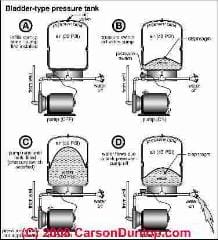 Charles' Law
Charles' Law
Charles' Gas Law explained, practical applications for building air conditioning, heat pumps, oil storage tanks, water pressure tanks, LP & natural gas systems
- POST a QUESTION or COMMENT about Boyles Law or Boyle's Ideal Gas Law
Charles' Law: this article describes and defines Charles Law, explaining the role of temperature in gas pressures, including examples of using Charles Gas Law to explain what happens to air in a water storage tank, LP gas in a gas tank, oil & fumes in an oil storage tank, or air conditioning /heat pump refrigerant liquid & gas volumes inside of an air conditioning or heat pump system.
InspectAPedia tolerates no conflicts of interest. We have no relationship with advertisers, products, or services discussed at this website.
Definition & Practical Applications of Charles' Gas Law
Charle's Law explains the relationship between the volume of a gas and its change with temperature. Simply put, Charles' law explains how and how much the volume of
any gas increases with increases in temperature or decreases when the temperature drops.
V1/T1=V2/T2
(V= volume, T= Temperature)
Charles Law Describes How Water Tank Air Pressure Changes With Shifts in Air Temperature in the Water Tank
What about the effects of changes in ambient temperature around a water storage/pressure tank? Suppose we wonder if seasonal temperature changes might cause important changes in in-water-tank pressure. For simplicity we'll work with a fixed volume full tank of just air. We'll change the temperature of the tank and its air from 60 deg.F. to 90 deg.F.
As most people would guess from practical experience, raising the temperature of a container of air while keeping the container size fixed will increase the pressure of air in the container.
Charles' Law: V1/T1=V2/T2
says that if we raise the temperature of a cubic foot of air, the air will want to occupy a larger volume.
30gal of air (or 4 cu. ft.) of air at 33 psi and at 60 degF is changed to 90 degF (by the warming ambient air) while the container size is kept constant.
Charles would say: 4cu.ft./60degF = NEWCUFT/90degF or 0.066 = NEWCUFT/90 0.066 x 90 = NEWCUFT or about 6 cu. ft.
This is 2 cu. ft. more than where we started, or a 50% increase in the starting volume of air.
Technical note: when working with the gas laws and temperature, all temperatures have to be converted to Kelvins or "K" - their Kelvin equivalent before the law can be applied. The Kelvin temperature scale relates temperature to absolute zero, where 0 Kelvins = absolute zero. We can convert Fahrenheit to Kelvins using this simple formula: K = (degF + 459.67) / 1.8.
We can convert Kelvins to Fahrenheit using this formula: degF = (K x 1.8) - 459.67. And for folks who work with Celsius, we can convert Celsius to Kelvin with this formula: K = degC + 273.15, or we can conver4t from Kelvin back to degrees of temperature in Celsius with this formula: degC = K-273.15.
(However for temperature intervals one degree Kelvin = one degree Celsius.) Also, 0 degrees Kelvin = -273.15 degC = -459.67 degF.
...
Continue reading at COMBINED GAS LAW or select a topic from closely-related articles below, or see our complete INDEX to RELATED ARTICLES. or select a topic from the closely-related articles below, or see the complete ARTICLE INDEX.
Or see these
Recommended Articles
- BLEVE EXPLOSIONS
- GAUGE, REFRIGERATION PRESSURE TEST
- OIL TANK PRESSURE
- OPERATING TEMPERATURES HVAC
- PRESSURE CONTROLS & SAFETY SWITCHES
- REFRIGERANT GASES & PIPING
- WATER TANK AIR PRESSURE ADJUSTMENT
- WATER TANK PRESSURE CALCULATIONS
Suggested citation for this web page
CHARLES' LAW at InspectApedia.com - online encyclopedia of building & environmental inspection, testing, diagnosis, repair, & problem prevention advice.
Or see this
INDEX to RELATED ARTICLES: ARTICLE INDEX to AIR CONDITIONING & HEAT PUMPS
Or use the SEARCH BOX found below to Ask a Question or Search InspectApedia
Ask a Question or Search InspectApedia
Try the search box just below, or if you prefer, post a question or comment in the Comments box below and we will respond promptly.
Search the InspectApedia website
Note: appearance of your Comment below may be delayed: if your comment contains an image, photograph, web link, or text that looks to the software as if it might be a web link, your posting will appear after it has been approved by a moderator. Apologies for the delay.
Only one image can be added per comment but you can post as many comments, and therefore images, as you like.
You will not receive a notification when a response to your question has been posted.
Please bookmark this page to make it easy for you to check back for our response.
Our Comment Box is provided by Countable Web Productions countable.ca
Citations & References
In addition to any citations in the article above, a full list is available on request.
- In addition to citations & references found in this article, see the research citations given at the end of the related articles found at our suggested
CONTINUE READING or RECOMMENDED ARTICLES.
- Carson, Dunlop & Associates Ltd., 120 Carlton Street Suite 407, Toronto ON M5A 4K2. Tel: (416) 964-9415 1-800-268-7070 Email: info@carsondunlop.com. Alan Carson is a past president of ASHI, the American Society of Home Inspectors.
Thanks to Alan Carson and Bob Dunlop, for permission for InspectAPedia to use text excerpts from The HOME REFERENCE BOOK - the Encyclopedia of Homes and to use illustrations from The ILLUSTRATED HOME .
Carson Dunlop Associates provides extensive home inspection education and report writing material. In gratitude we provide links to tsome Carson Dunlop Associates products and services.

